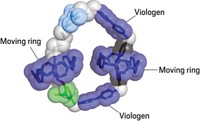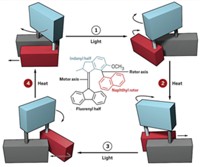Advertisement
Grab your lab coat. Let's get started
Welcome!
Welcome!
Create an account below to get 6 C&EN articles per month, receive newsletters and more - all free.
It seems this is your first time logging in online. Please enter the following information to continue.
As an ACS member you automatically get access to this site. All we need is few more details to create your reading experience.
Not you? Sign in with a different account.
Not you? Sign in with a different account.
ERROR 1
ERROR 1
ERROR 2
ERROR 2
ERROR 2
ERROR 2
ERROR 2
Password and Confirm password must match.
If you have an ACS member number, please enter it here so we can link this account to your membership. (optional)
ERROR 2
ACS values your privacy. By submitting your information, you are gaining access to C&EN and subscribing to our weekly newsletter. We use the information you provide to make your reading experience better, and we will never sell your data to third party members.
Materials
Molecular Motor Spins on Surface
Light-driven rotors could lead to more complex nanoscale devices
by Bethany Halford
October 31, 2005
| A version of this story appeared in
Volume 83, Issue 44
Nanotechnology
By anchoring a chiral helical alkene onto a gold nanoparticle, chemists in the Netherlands have created the first light-driven molecular rotary motor attached to a solid surface (Nature 2005, 437, 1337). This mounted molecule, the researchers say, might be a first step toward the construction of more elaborate and functional nanosized mechanical devices and perhaps systems to exploit solar energy.
Fastening a rotary molecule to something solid, as Ben L. Feringa and colleagues at the University of Groningen have done, brings these spinning systems closer to becoming useful nanomachines.
Putting motors on a surface is important because it should make it easier for them to do useful things, like move themselves or cargo, or change the nature of the surface in response to a stimulus, says T. Ross Kelly, a Boston College chemistry professor who made a molecular motor that runs on chemical fuel.
Feringas team uses two thiol groups to affix their molecular motor to a gold nanoparticle. Two eight-carbon legs link these thiols to the alkene motor. The researchers note that they chose this lengthy anchor to minimize any direct electronic interaction between the alkene and the gold particle.
The researchers start the motors rotation by photoisomerizing the double bond. This forces the methyl group on the molecules lone stereocenter into an energetically disfavored orientation. When heated, this unstable isomer undergoes a helical inversion, resulting in a net 180 rotation. This step also ensures unidirectional movement. Repeating the two isomerizations completes the 360 revolution.
Vincenzo Balzani, a molecular machine pioneer at Italys University of Bologna, notes that Feringas motor doesnt do any work at present. He adds, however, that the system has the intrinsic advantage of being light driven. It is indeed an important step toward the construction of artificial systems that, in the long run, will hopefully lead to the exploitation of solar energy for information processing or energy-conversion purposes.






Join the conversation
Contact the reporter
Submit a Letter to the Editor for publication
Engage with us on Twitter